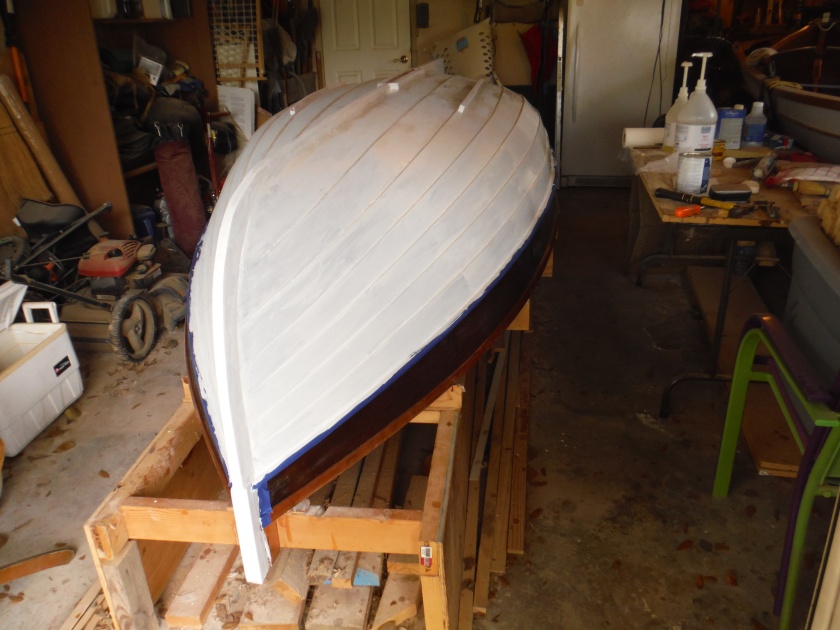The hull looked beautiful with the first coat of epoxy sealer applied, but that wouldn’t last. Before putting on the second coat of sealer, the hull has to be sanded. Sanding won’t ever make anybody’s list of favorite things to do, but it has at least two purposes: 1) it provides a “tooth” for the next coat to adhere to; and 2) sanding quickly shows up any drips or runs you made, and gives you the opportunity to remove them. Sanding in general is not fun; sanding epoxy is even less so, but it needs to be done. I chose to sand by hand using a rubber sanding block; using the jitterbug (electric palm sander) likely wouldn’t have saved me much time and would guarantee an even bigger mess in the garage. My wife says I generated enough white dust as it was.
The boat can be sanded down in a day, and at the end of the day, you’ll sleep good at night. The second coat of sealer went on without any difficulty, and was given a week to cure. With the second sealer coat on, the hull looked really nice, and I thought briefly about varnishing the outside of the hull rather than painting it.
Scratch that as a silly idea.
The sealer, like any epoxy, is not UV resistant, and so needs several protective coats of varnish if left bright. Even the best of varnishes are only UV resistant, which means where I live, the varnish really needs to be freshened up every year. Wee Lass has a entirely bright-finished interior, and putting on fresh varnish is an annual ritual. The inside of the hull can be light sanded can be sanded in a weekend, and a coat of varnish applied the next Saturday. It’s a chore, but not a bad one. Now consider varnishing the exterior. That means I’ll be taking the boat off the trailer, flipping it upside down onto sawhorses, and then putting it back on the trailer when the varnish is done. That will get old very quickly.
Like I said, it was a really silly idea. The exterior will get paint, which will last a lot longer than varnish.
So with the second coat of sealer on, the hull gets sanded again, and it’s at this point that I’m really glad that I’m building a 14-foot boat and not a 20-foot boat. I could not have sanded a 20-foot boat in a day.
My brother told me yesterday that when he built his boat, his friend teased him about putting $100 worth of epoxy on the boat, and then sanding $75 of it away. There’s a kernel of truth in that statement.
This morning I put on the first coat of primer, after carefully masking the lower rubbing strip and the transom. The primer went on without any issues, except that my wife pointed out that open garage doors are a must when using the stuff. The temperature outside was just barely warm enough, and my garage is not much warmer, so it will take awhile for the primer to dry. Already I can tell it will need a second coat. The next step (sinister music in background) will be more sanding, but hopefully this will be easier than sanding epoxy.

A lot more sanding,,,,, aaaaarrrrgggg!!!…. I think that may be one reason I quit boat building… after 18 boats. BUT ! if you don’t do it, it will not look RIGHT !…. Wish I could be there to help Al…. on the other hand… rrr
me
b
LikeLike